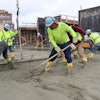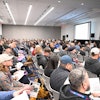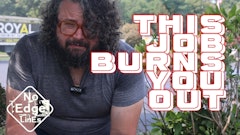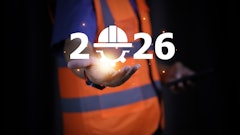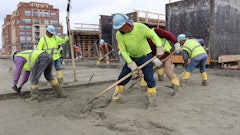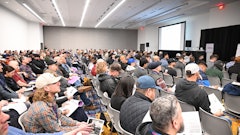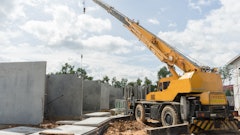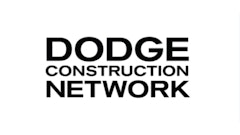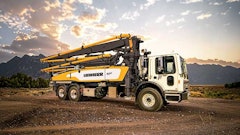
Rock Solid Stabilization & Reclamation, headquartered in Genoa City, WI, recently completed one-mile test sections for both Cass County, ND, and Hebron Township in McHenry County, IL, that doubled as preservation demonstrations for the company and the Asphalt Recycling & Reclaiming Association (ARRA).
“Cass County had a one-mile section of 158th Ave. SE that we repaired, approximately a half mile was existing pavement that was about 30 or more years old with cracking every 20 feet or so, but still in okay shape,” says Jonathan Pease, president of Rock Solid. “The last ½ mile of was gravel only.”
The test projects had two objectives, says Pease. “First, it allowed our industry to showcase various techniques, materials and processes, including pavement preservation scopes, in a live demo application,” he explains. “Second the project allowed the county and neighboring DOTs to connect with the county to see how the test strips performed and start utilizing them on other applicable projects.
“Live demonstrations are always more impactful than a PowerPoint or other forms of presentations,” he continues. “Bringing the audience into the field will net a greater understanding of the industry potential.”
Rock Solid Stabilization & Reclamation was formed in April 2007 to supply the increasing demand for soil stabilization and soil modification throughout the Midwest. Initially a subsidiary of Pease Construction, Rock Solid responded to the growing demand by expanding their expertise in soil modification and restructuring methods, its goal being to save customers valuable time, money, and resources, and to “Support Infrastructure Responsibly.”
The company soon realized that by pursuing rehabilitative methods and doing jobs in-place that conserved existing materials rather than performing wasteful and costly undercuts, it could build projects that were vastly more efficient, environmentally responsible, and cost effective for its clients.
Recognizing that clients were also looking for help planning projects and solving logistics problems, Pease decided to expand the vision and establish Rock Solid as its own business. Using its valuable field experience and accumulated knowledge, Rock Solid has since developed a focus on value engineering —working with clients from the start of their projects all the way to the very end to ensure the best possible outcomes in terms of performance, quality, reliability, safety and use of natural resources.
The company performs pulverization, soil stabilization, soil modification, full depth reclamation (FDR), and cement-treated base projects in 21 states ranging from California to New York and Texas to North Dakota. Rock Solid has processed over 60+ million square yards of unsuitable soil & deteriorating pavement and salvaged 3 million tons of aggregate and pavement on DOT, local agency, and private projects since 2010.
Treatments
On the one-mile section of 158th Ave. SE, the northbound and southbound lanes were broken into segments, and each segment received a different treatment.
On the Northbound lane, the four segments included:
- Segment 1: 5” full-depth reclamation (FDR) with emulsion on 5” salvaged gravel/asphalt blend on 12” soil cement with a thin surface treatment
- Segment 2: 12” FDR with cement and a thin surface treatment
- Segment 3: 4” emulsion with thin surface treatment
- Segment 4 (gravel section): 12” lime treatment then cement treatment with a gravel cap
On the Southbound lane, a 12” FDR with cement and thin surface treatment was used. On the gravel section, a 12” lime treatment then cement treatment was used.
“In the gravel section to the south ½ mile, ¼ mile stayed gravel with a lime/cement subgrade improvement to all better performance of the gravel and subgrade from rutting,” explains Pease. “The remaining ¼ of the (1/2 mile) gravel section was improved and capped with either a thin hot mix overlay or a Cape Seal as alternatives to dust control.
“The Northbound lane of the ¼ mile of gravel-to-hard surface was improved from a gravel surface to a 4” emulsified gravel with a Cape Seal overlay for approximately $5 per square yard, thus the ROI on normal dust control would be approximately 4 to 5 years and will eliminate dust and graveling of the road for years to come,” he continues.
According to Pease, the rest of the sections where designed to only gain structural coefficient over the original cross section.
The two surfaces used where a thin hot mix overlay that Border States Paving wanted to experiment with and Astech, which performed the Cape Seal. “Both of these where chosen for a few reasons, but mostly as a wear coarse as the structural integrity of the road is in the FDR and stabilization processes,” says Pease.
As with any project, there were several challenges to overcome.
“Being a live demo and using some alternative materials in the industry, trying to get supply was a challenge at times,” says Pease. “We had to pull emulsion from Illinois as no local source would sell it to us. Weather in a live demo can be a challenge too, but that’s just construction and you deal with it.”
The primary equipment used for the demo included a WR250 Wirtgen reclaimer, RM500 Caterpillar reclaimer, and Stolz site spreaders.
What’s next?
The next step for this pilot project is observation, says Pease.
“Now the project will sit for the winter for all to observe and to see the performance of the roadway to determine in any other cross sections would be a fit for upcoming work in the area,” he says.
Pease says this test project is a great way to show not only the various ways to preserve a pavement but which is most cost effective and long-lasting for that particular road. It’s also a great way to show cooperation between all parties.
“The fact that it’s a live test strip on a larger scale of various cross sections all side by side, in both gravel and paved sections, shows alternative ways of redoing the roads at up to 50%+- savings over traditional processes,” he says. “It also shows the agency, contractor, suppliers and equipment manufactures all can come together to pull this off.”


